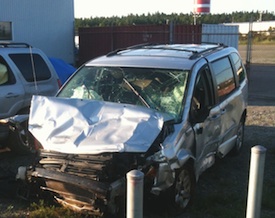31 Aug How my family survived a highway crash
The five occupants of this 2008 Dodge Grand Caravan — my son, daughter-in-law, and three grandchildren — survived a head-on collision on the TransCanada Highway Thursday evening. I offer the following details in hopes that other families will find it helpful to understand the factors that decisively improved their chances of survival.
Shortly before 5 p.m, August 26, my family was westbound on Route 105 in Lexington, Nova Scotia, just north of the Canso Causeway, when a severe rain squall hit the area. Daughter-in-law Jenn had just slowed down when an eastbound car apparently hydroplaned and spun across the centerline into their path.

Grandson Jacob, age 6, suffered a broken femur. The others — Jenn, my son Silas, Jacob’s twin brother Josh and sister Maggie, 8 — were badly bruised and badly shaken. Surgeons at the IWK-Grace Hospital in Halifax repaired Jacob’s leg Saturday. Doctors expect all to recover fully. We are grateful to them, and to the EMTs and volunteers who responded to the crash.
The driver and lone occupant of the other car, Marlene MacDonald of Port Hawkesbury and Washabuckt, died at the scene.
I offer my sincere sympathy to Ms. MacDonald’s daughters, grandchildren, and siblings. Events like this cause those affected to reflect on counterfactual alternatives; since Thursday, our family and friends have thought constantly of the MacDonald family’s suffering, and how easily it could have been ours. I am sorry for their loss.
Death and injuries in car crashes result not from a vehicle’s collision with another object but from what’s sometimes called the second collision — that of the occupants with the inside surfaces of the car. The second collision occurs a fraction of a second after the first.
Here are some of the factors that made the second collision survivable in my family’s case:
- Jenn reduced speed to reflect driving conditions, lessening the force of the subsequent impact.
- In response to legislation, insurance company pressures, and consumer demand, automobile manufacturers have made tremendous improvements in the crashworthiness of their cars over the last decade. Modern vehicles are better engineered to absorb and dissipate the force of sudden impacts while maintaining the integrity of the passenger compartment.
- Jenn and Silas drove a 2008 Dodge Grand Caravan equipped with front and side airbags. The Insurance Institute of Highway Safety gives this model a “good” rating (its highest) for “frontal offset” and “side impact” test results. You can check the crashworthiness of your car here.
- All the occupants were secured with optimal, industry-recommended safety equipment: the adults with standard lap-and-shoulder belts; the eight-year-old with a child’s safety booster seat held in place by a lap-and-shoulder belt; the six-year-olds by properly secured child safety seats appropriate to their size and weight.
The last point merits emphasis. For many families, child safety seats are expensive to purchase and tedious to install and use. After Thursday, the expense and inconvenience look pretty small to us, the benefits enormous.
Finally, a word of thanks to the numberless, nameless engineers, auto executives, safety advocates, insurance industry risk analysts, and legislators who helped my dear family survive.
Their survival is not a miracle. It is the result of considered steps by real people to improve highway safety.

